
Remember those kitchen cabinet pulls I installed at Fred and Kim’s house? Did I mention that their air conditioning wasn’t working that day… and that it was 100° outside when I did those? I didn’t? Well, it was miserable.
The Fauth family came to our place to cool off that night, and I told Fred and Kim how a while back our HVAC quit working because the condensation drain was clogged. They went home and checked, and sure enough, found their drain line full of dust, rust, and other gunk. Water pooling inside the drain pan of the air handler was preventing the coils from cooling down, ultimately robbing cold air from the rest of the house.
Fred took a temporary measure and cut the drain pipe, then directed the water into a bucket which had to be emptied every 12 hours. It’s a better solution than having interior temperatures reach 90°, but it wasn’t a permanent solution.
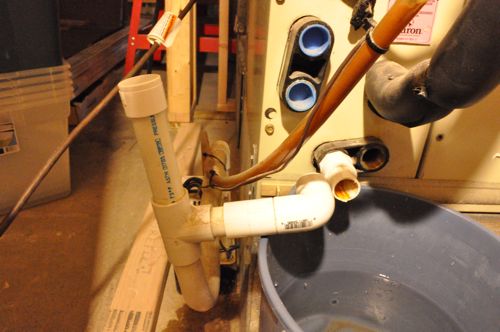
When my HVAC unit was replaced, the pros installed a clear plastic trap so we can see when it needs to be cleaned. I thought it should be simple enough to install one at Fred’s and Kim’s house. Unfortunately, none of the big box stores carry that component, so I improvised.
You can do this project too, if you find your air conditioner giving out due to a condensation line clog.
How to Replace an Air Conditioning Drain Line
My goal was to piece together a new drain line and use some clear flexible tubing to recreate the trap. The trap would collect any gunk, and adjustable clamps would allow access for cleaning.
I had a gift card for Lowe’s so that’s where I picked up my supplies — ¾” PVC, various fittings, 1′ of clear tubing, a pack of metal clamps (the kind you tighten with a screw driver) and PVC cement. Since this was a drain line and wouldn’t be under pressure, I didn’t need to use any PVC primer (that purple stain you often see on PVC).
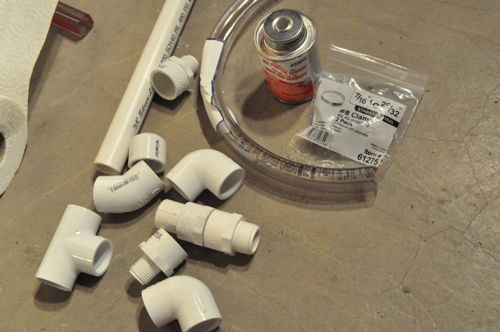
Here’s a picture of the existing PVC. The drain goes to a small pump.
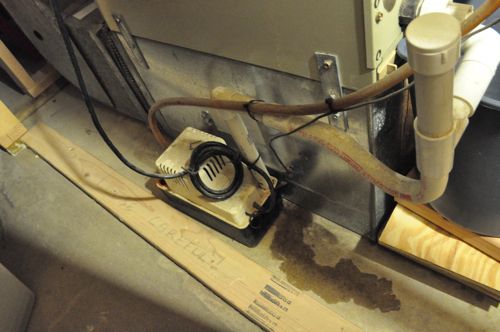
Here’s a pic of the old drain removed. It was nasty.
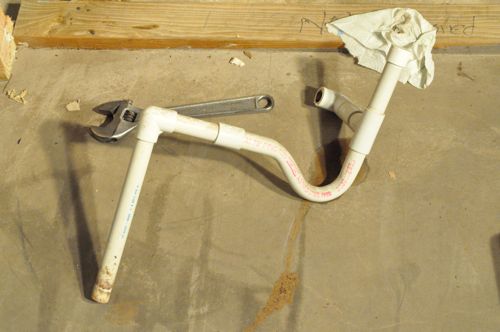
Using the old drain as my template, I began dry fitting everything together.
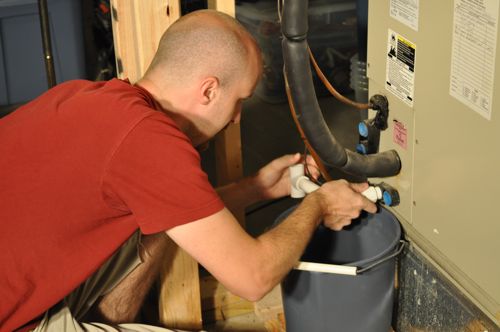
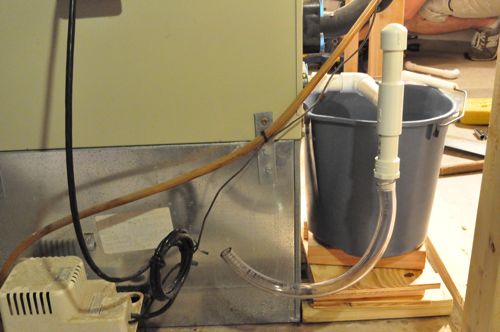
Working the tubing in place.
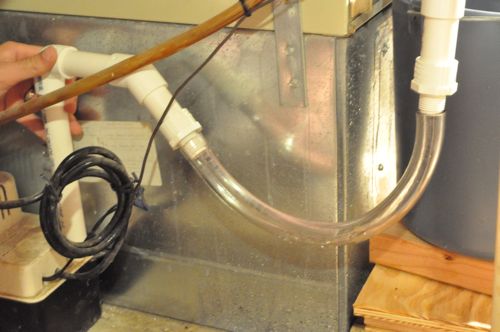
The old drain had a removable cap. I’m not sure if it was to introduce some air or another reason, but I recreated that too.
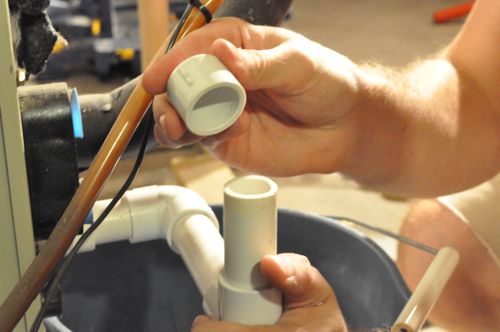
If you’ve ever worked with PVC before, you know that it’s important to make clean, straight cuts and to remove any burrs and debris. We had a miter saw handy and it worked well. Disregard my lack of safety glasses.
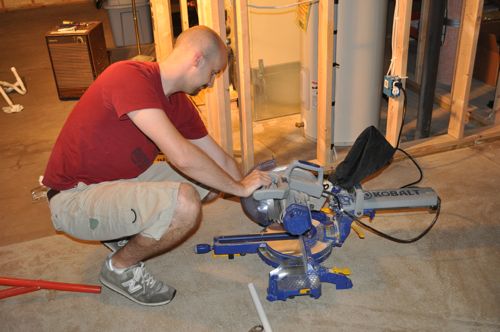
When I was satisfied that everything fit together, it was time to start gluing. PVC cement is a chemical solvent that melts the two pieces together making a super strong bond when it cures.
Be sure to fully seat the PVC inside the fitting. It’s also a good idea to give it a little twist to ensure good coverage.
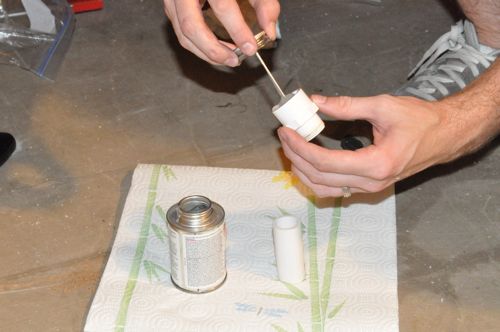
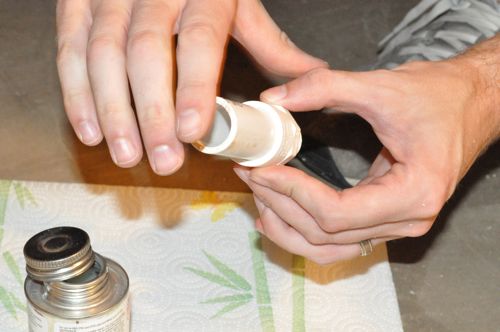
Keep everything in the right orientation, otherwise you’ll end up with PVC going in the wrong direction.
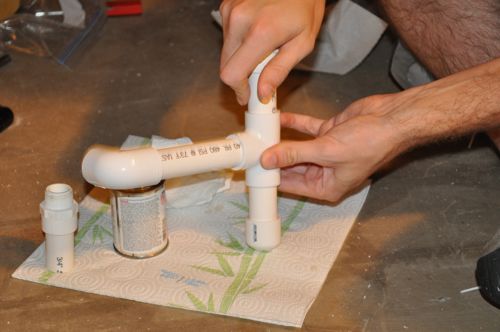
This is the metal clamp I used to secure the flexible tubing. Turning that screw allows you to tighten or loosen the clamp.
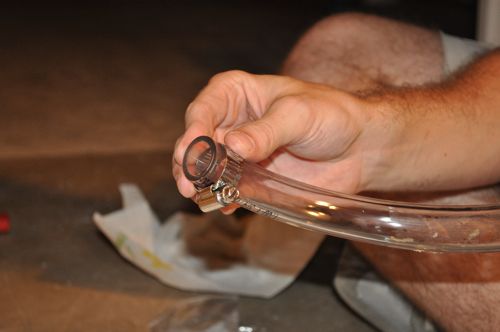
I actually ended up gluing the left side of the flexible tubing (in addition to the metal clamp) as there was a small leak.
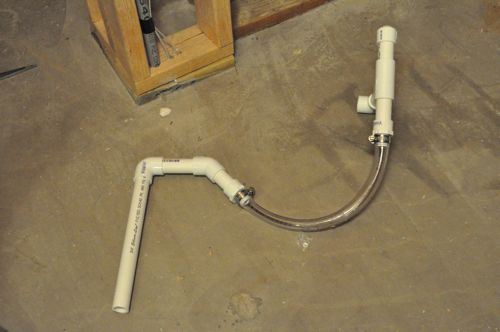
Can you see the water in the trap?
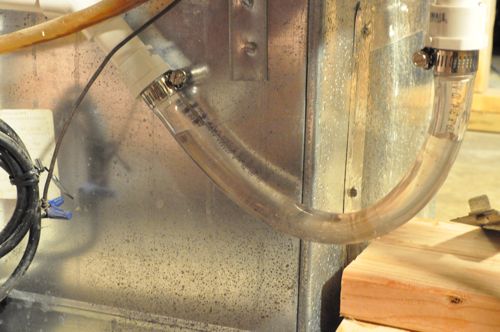
Here’s a close-up of the bracket I used to keep the PVC in the right spot.
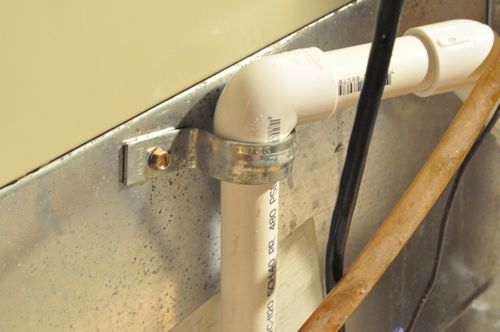
When it was all finished, we flushed the line with water to make sure it didn’t leak and everything worked as expected. Fred and Kim have their A/C back and I get to share a great how-to with all of you. I love it when a plan comes together!
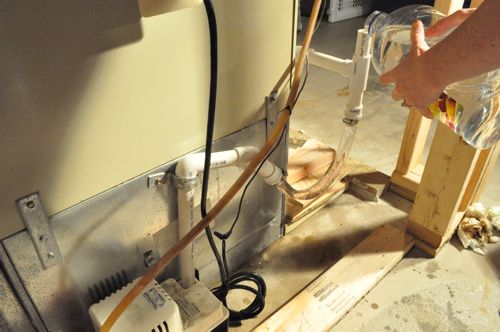
Have you ever had to tackle and issue with your HVAC unit? Do you remember to change your air filters? What have you made out of PVC before?







This is great info. If you need more tutorials I have lots of broken things at my house. Come on over!
LOL. We already have too many projects around here!
Wow! Has anyone ever called you MacGyver before? 🙂
Not until now. Thanks Carol!
Brilliant! That was really cool and a solution I hadn’t thought of before. My family’s AC unit is pushing 20 and I think something like this may well be necessary soon.
As for things I’ve made of PVC….do projector screens and puppet show theaters count? 😀
Screen and theaters definitely count!
That removable cap you didn’t know the purpose of? It’s to prevent this very problem! Every six months, you’re supposed to pull the cap and pour in about a teaspoon of bleach to keep the line clean. This will keep your system from clogging up and you’ll never have to replace all of that PVC again!
Mark, That’s great info! I checked their line yesterday and I’m already seeing small bits of debris accumulate in the trap. Will bleach dissolve those? It doesn’t seem likely.
My system was installed about a year ago and the U- shaped trap has a brush to remove debris. Are newer systems moving away from the bleach solution?
Most DIY articles say a cup or more of bleach not just a tablespoon. A tablespoon is just not enough liquid to contact with all the algae that can build up along the line.
I have a current problem I’m trying to figure out how to solve: The drain from my attic A/C pan is running constantly out onto the 1st story roof on the front of the house and it’s now starting to stain the roof and the nearby window and siding an ugly reddish (rust) color. Also, with all the wetness, I think some algae is growing on that part of the roof.
1. Is this indicative of a problem with the A/C? Should it be constantly draining to the front of the house? (I read somewhere that this is only an emergency drain, not the primary drain – could this be an indicator that the primary drain is clogged?)
2. How do I clean the roof and siding from this rusty, algae combo?
Any ideas? Thanks in advance.
Hey Scott,
If I remember correctly, your roof is relatively new, and the shingles should have copper granules that help prevent algae. With that said, constant water flowing over them may have “used up” all the copper. I think careful pressure washing will remove the stain and algae. Keep the water flowing down roof- never shoot water under the shingle, and keep the pressure low.
Without seeing your HVAC unit, it’s tough to offer any suggestions. If water is indeed flowing from an emergency drain, that sounds like a problem to me. I’d remove the cover on the front of your unit and inspect the pan, coils and drain. If you see sitting water, that’s a bad sign.
My primary drain that I think is clogged doesn’t have a removable cap, so I’m going to try hooking a shop-vac up to the end of the drain and sucking out whatever might be clogging it.
Found the suggestion here: http://www.dannylipford.com/video/ac-drain-clean-out/
Thanks for the tips!
Scott
Our AC was just broken too — but it was the “defrost panel”. I have no idea. I just hired someone. 🙂
I think our drain is copper though, so it’s especially hard to check if it’s clogged…
I see most of my comments have already been covered, like the purpose for the removable cap that you already figured out 🙂 when you used it to flush the system.
But I do have something else to add to that. you want to flush MORE bleach than just a teaspoon through the system, like a quarter cup in a gallon of water (pour that through, then flush it with another gallon of clean water to make sure the bleach doesn’t sit). Its not just for the trap, its for the condensate pump as well. I dare you to open that up, its going to be NASTY, I can tell because that ugly brown/yellow tube from the pump, it probably started out as clear tubing, and has algae in it.
Also, you might want to re-evaluate the idea of not needing primer, it will be under a light vacuum pressure, and the drain in my parent’s house separated right where it attaches to the condensate pan, causing a fun leak.
Now I will share my own experiences with this joyous subject! sorry its going to be long.
Thankfully my house has been OK, but the AC is only a year old, so I would hope so. But my parent’s house is an entirely different story, this summer I got to fix two separate issues, and I expect there will be more, I REALLY hate part of their setup (6 air handlers, each with their own condenser outside and sharing two heat pumps), two of their air handlers are in the unheated attic, and have NO emergency drain pan, and the condensate dumps into a questionable part of the plumbing system (vent pipe in the attic, where it looks like it pools inside it). Then in the basement there are two condensate pumps dumping into another drain line (directly). OK, done ranting about the design.
I (and when I say I in this case, I mean myself and my father in law, who is a plumber) had to replace one condensate pump which had probably been failing since last summer (no-one noticed it), simple job (except it was hard wired inside of the air handler O_o), and the old one was full of very nasty slime, so I will make it a point to flush out the pumps there in the future. Then in the attic we had to replace a trap which had frozen a few years ago (this one was only cracked, and wasn’t really leaking more than the pie pan they had under it would catch, the one right next to it cracked wide open and leaked through the ceiling). The pipe going to the trap had broken right where it connects to the condensate drain and started leaking through the ceiling (again!!!). We just replaced everything, trap included. Unfortunately I wasn’t thinking about it at the time, or I would have added the cleanout that you did. I might do it next year, and add the sweet clear trap.
I think I will show my father this how-to as his system(furnace mostly) is really old and he has had blockage issues with his old AC unit and a blockage( he did replace it 4 years ago-The outside n coils in the furnace). I know how to change a filter but this would definitely be a job for the men in my family. Ugh I too suffered with out A/C for a good 5 years so I can imagine how Fred’s family felt.
I find it fun to work with PVC pipe. It’s easy to cut and glue, results are realized fast and it’s cheap. I gave my 4 year old grandson a box of cut 1/2″ pipe pieces and couplings. No glue at his age, of course. He loves putting the pieces together in different ways to build towers and other imaginary structures. The whole box of “parts” cost just over $10.
I have also used PVC pipe several times as a moving aid. It’s much cheaper than steel pipe, but it’s very strong when used as rollers, like the logs Egyptians used to move stone blocks. I used 2″ PVC pipe as rollers to move a garden sheds across the yard. I used 1-1/2″ PVC pipe under pallets of 16′ cement-board siding to move the load from my driveway into the garage, Great stuff.
Wayne, first time I’ve seen you around these parts. Welcome!
Love both ideas for PVC. My 6 year old is VERY into building with Legos and blocks. I had never thought that he might enjoy a PVC pipe site. You could also make it so he can run marbles through it… You’ve got the wheels turning in my head.
Also, good tips on the 2″ PVC pipe for rolling heavy objects. I hadn’t heard that before but it certainly is a novel use that makes a lot of sense.
Welcome again and hope to see you back often!
My home is 24 years old and I believe the upstairs air handler is original-it has a know freon leak, so it gets serviced every other year. I will have to check the drain (great article) when I get back from SW Asia. Any ideas how I can detect/mitigate the leak and help the unit make it thru a few more seasons?? Replacement is probably the best fix, but $$ is tight…
Thanks!!
Hi Tyro! First time I’ve seen you here, so welcome to the site. What part of SW Asia are you traveling to? Hope you’ll stop by during your travels 🙂
I love this article. HVACs always seem a bit intimidating to me, but this post shows that with a little critcal thinking combined with practical experience can resolve almost any problem.
Great article , the best thing i love about this blog is these photos which really describes everything perfectly , thanks for this great work . Thumps up . i always have difficulty in replacing HVAC condensation drain.
My Daddy was a furnace man when I was little and I have a very handy hubby so I’ve personally never had to deal with anything other than making sure the drain tube didn’t get pulled out of the drain. I don’t think we have a trap on either of ours. We have two furnace/heat pump systems. I’ll have to check on that.
Love the A-Team comment and Carol is right, you’re very MacGyver like. 🙂
If you make a drain out of PVC you can use thin wall tubing instead of sch 40. Works just as well. I just replaced my J tube (condensation drain) with a hard plastic piece of tubing. You just need to create a p-trap setup so sewer smell doesn’t get sucked into heater.
My house is about 20 years old, and my 3rd AC unit quit the other day. My AC repairman cleaned my clogged drain line, but he says I need a new drain line because the current one is still clogged with stuff he can’t vacuum out. In fact, it started working again but is making the same waterfall-type sounds that it was making when it quit the other day. I hate to think how much that is going to cost. It sounds like they have to replace the entire line, not just the part near the unit like you did. Do you think they are telling me the truth or just trying to rip me off? By the way, they recommend pouring vinegar into the drain cap instead of bleach. Sounds more environmentally friendly.
Hi Lynn, replacing your drain lines will fix the problem but it can get expensive. So, before you pay for anything, try this…
Go to home depot. Buy a jug of hair and grease declogger for about 12 bucks. go to the main line and pour half of the jug in the line. wait about an hour and pour hot water down the drain. about a half gallon. 99% confident this will clear your line. But, the next day do it again. the rest of the jug and a gallon of hot water. Just make sure to turn off the unit before you pour anything. It works pretty well. good luck! JAT
http://www.homedepot.com/p/Instant-Power-67-6-oz-Hair-and-Grease-Drain-Opener-1970/100169339?cm_sp=BazVoice-_-RLP-_-100169339-_-x
It’s awesome for me to have a site, which is good in support of my knowledge.
thanks admin
bleach isn’t the ideal solution for PVC or CPVC because of the chemical properties. Poly Vinyl Chloride piping will tend to get a little brittle over a long time with bleach which is sodium hipochlorite salt disolved in water. Basically NaClO (bleach) will slowly oxidize the PVC, similar to how it would a metal pipe, which makes it more crystalline and brittle. What the bleach is doing is killing the bacteria and other beasties in the goo that forms on condensation coils when the AC unit is condensing water and whatever else is floating around in the air. One fairly effective way to minimize sludge build up is to use a air handler filter with a MERV rating of 11 or higher. There is a draw back to this because the filter will tend to develop a higher differential pressure as it filters things out, meaning you’ll be changing a more expensive filter more often (I actually run my air handler continuously and change the filter every month.) A lot of sources say vinegar works well for cleaning condensate lines, but all of the vinegar I have in the house typically is balsamic, or other non-white to expensive for drain clearing in variety. I use Spray Nine or Simple Green cleaner, either of which are anti-bacterial. About every 6 months or so I pour whatever is left out of a nearly empty bottle down the trap clean out cap before I refill the bottle with cleaner, I would guess it ends up being an ounce, sometimes two ounces.